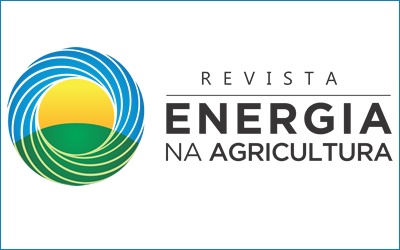EVOLUÇÃO DIURNA E ANUAL DA FREQUÊNCIA DAS COBERTURAS DE CÉU EM BOTU-CATU/SP
DOI:
https://doi.org/10.17224/EnergAgric.2012v27n1p37-52Resumo
Neste trabalho foi apresentada uma análise do padrão de variação da cobertura de céu em Botucatu/SP. A classificação foi realizada com base no índice de claridade KT. Utilizou-se na classificação uma base de dados de irradiação solar global na horizontal, medida na Estação Radiométrica da UNESP em Botucatu (latitude 22,85ºS, longitude 48,43ºW, altitude 786m) entre os anos de 1996 a 2005. Foram analisadas as variações na frequência, ao longo do fotoperiodo e do ano, das coberturas de céu: I - nebuloso (KT < 0,35); II - parcialmente nebuloso com dominância para o difuso (0,35 < KT ≤ 0,55); III - parcialmente nebuloso com dominância para o claro (0,55 < KT ≤ 0,65) e IV - claro (KT > 0,65). A frequência das coberturas de céu I e II é maior ao longo do período chuvoso do ano e nos horários próximos ao nascer e pôr-do-sol. E é menor durante o período seco do ano e nos horários próximos ao meio dia, nos quais há predominância das coberturas de céu III e IV. A frequência horária mensal da cobertura de céu I variou de 46,91% do fotoperiodo em janeiro a 25,27% em agosto. E a frequência diária mensal variou de 9 dias em janeiro a 3 dias em agosto. Para a cobertura de céu IV, a frequência horária mensal variou de 38,81% do fotoperiodo em agosto a 18,17% em janeiro. E a frequência diária mensal variou de 17 dias em agosto a 3 dias em janeiro.
Palavras-chave: Índice de claridade, nebulosidade, radiação solar.
DIURNAL AND ANNUAL EVOLUTIONS OF THE FREQUENCY OF THE SKY CONDITIONS IN BOTUCATU/SP
SUMMARY: This work presents an analysis of the pattern variation of the sky conditions in Botucatu/SP. The classification was based on the clearness index KT. It was used in the classification a database of global solar irradiance in the horizontal, measured at Radiometric Station of UNESP in Botucatu (latitude 22.85°S, longitude 48.43°W, altitude 786 m) from 1996 to 2005. We analyzed the variations in frequency, during the photoperiod and over the year, of the sky conditions: I - Cloudy (KT < 0.35); II - partly cloudy with dominance for the diffuse (0.35 < 0.55 ≤ KT) III - partly cloudy with dominance for the clear (0.55 < KT ≤ 0.65) and IV – clear (KT > 0.65). The frequency of sky conditions I and II are higher during the rainy season of the year and in hours close to sunrise and sunset. And it is lower during the dry season and in hours near noon, in which there is a predominance of sky conditions III and IV. The monthly hourly frequency of sky condition I ranged from 46.91% of the photoperiod in January to 25.27% in August. And the frequency monthly daily ranged from nine days in January to three days in August. To the sky condition IV, the frequency monthly hourly ranged from 38.81% of the photoperiod in August to 18.17% in January. And the frequency monthly daily ranged from 17 days in August to three days in January.
Keywords: Clearness index, cloudiness, solar radiation.
Downloads
Publicado
Como Citar
Edição
Seção
Licença
Esta revista proporciona acesso publico a todo seu conteúdo, seguindo o princípio que tornar gratuito o acesso a pesquisas gera um maior intercâmbio global de conhecimento. Tal acesso está associado a um crescimento da leitura e citação do trabalho de um autor. Para maiores informações sobre esta abordagem, visite Public Knowledge Project, projeto que desenvolveu este sistema para melhorar a qualidade acadêmica e pública da pesquisa, distribuindo o OJS assim como outros software de apoio ao sistema de publicação de acesso público a fontes acadêmicas.





